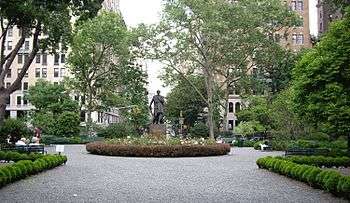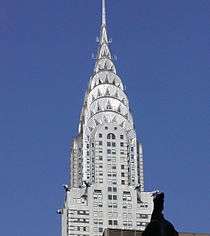Gramercy Park
| Gramercy Park | |
|---|---|
| Neighborhood and park in Manhattan | |
|
The view from the south gate of Gramercy Park, looking north from Gramercy Park South (East 20th Street), with the statue of Edwin Booth in the center. The Gramercy Park Hotel is visible in the left background. (May 2007) | |
| Coordinates: 40°44′16″N 73°59′10″W / 40.73778°N 73.98611°W | |
| Country |
|
| State |
|
| City |
|
| Borough | Manhattan |
| Population (2010)[1] | |
| • Total | 27,988 |
|
Gramercy Park Historic District | |
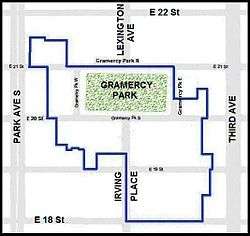 | |
| Location |
Manhattan, New York City |
|---|---|
| Coordinates | 40°44′16″N 73°59′10″W / 40.73778°N 73.98611°WCoordinates: 40°44′16″N 73°59′10″W / 40.73778°N 73.98611°W |
| Architectural style | Greek Revival, Italianate, Gothic Revival |
| NRHP Reference # | 80002691 |
| Added to NRHP | January 23, 1980[2] |
Gramercy Park[note 1] /ˌɡræmərsi ˈpɑːrk/ is the name of both a small, fenced-in private park[3] and the surrounding neighborhood that is referred to also as Gramercy,[4][5] in the borough of Manhattan in New York City, United States.[6]
The approximately 2-acre (0.81 ha) park, located in the Gramercy Park Historic District,[7] is one of two private parks in New York City – the other is Sunnyside Gardens Park in Queens[8][9][10] – as well as one of only three in the state;[11] only people residing around the park who pay an annual fee have a key,[12] and the public is not generally allowed in – although the sidewalks of the streets around the park are a popular jogging, strolling and dog-walking route.
The neighborhood, which is divided between New York City's Manhattan Community Board 5 [13] and Manhattan Community Board 6,[14] is generally perceived to be a quiet and safe area.[12]
The neighborhood, associated historic district, and park have generally received positive reviews. Calling it "a Victorian gentleman who has refused to die", Charlotte Devree in the New York Times said that "There is nothing else quite like Gramercy Park in the country."[15] When the New York City Landmarks Preservation Commission created the Gramercy Park Historic District in 1966, they quoted from John B. Pine's 1921 book, The Story of Gramercy Park:
The laying out of Gramercy Park represents one of the earliest attempts in this country at 'City Planning'. ... As a park given to the prospective owners of the land surrounding it and held in trust for those who made their homes around it, Gramercy Park is unique in this City, and perhaps in this country, and represents the only neighborhood, with possibly one exception, which has remained comparatively unchanged for eighty years — the Park is one of the City's Landmarks.[7]
Boundaries
Gramercy Park itself is located between East 20th Street (called Gramercy Park South at the park), and East 21st Street (called Gramercy Park North), and between Gramercy Park West and Gramercy Park East, two mid-block streets which lie between Park Avenue South and Third Avenue. Irving Place commences at the southern end of Gramercy Park, running to 14th Street, and Lexington Avenue, a major north-south thoroughfare on the East Side of Manhattan, terminates at the northern end.
The neighborhood's boundaries are 14th Street to the south, Third Avenue to the east, 23rd Street to the north, and Park Avenue South to the west.[12] Nearby are the Flatiron District to the west, Union Square to the southwest, the East Village to the south, Stuyvesant Town and Peter Cooper Village to the east, Rose Hill to the northwest, and Kips Bay to the northeast.[note 2]
The boundaries of the Historic District, set in 1966[7] and extended in 1988,[16] are irregular, lying within the neighborhood, and can be seen in the map in the infobox on the right. A proposed extension to the district would include more than 40 additional buildings on Gramercy Park East and North, Lexington Avenue, Park Avenue South, East 22nd and East 19th Streets, and Irving Place.[17]
Etymology
The area received its name as an anglicization of "Crommessie",[18] which is derived from the Dutch Krom Moerasje, meaning "little crooked swamp",[19] or Krom Mesje, meaning "little crooked knife",[20] describing the shape of the swamp, brook and hill on the site. The brook, which later become known as Crommessie Vly,[21] flowed in a 40-foot gully along what is now 21st Street into the East River at 18th Street. "Krom Moerasje"/"Krom Mesje" became corrupted to "Crommessie" or "Crommashie".[18][20][21][22] Mayor James Duane – for whom the city's Duane Street is named – acquired the site in 1761 from Gerardus Stuyvesant and named it "Gramercy Seat".[23][24][25] "Gramercy" is an archaic English word meaning "many thanks".[26]
History
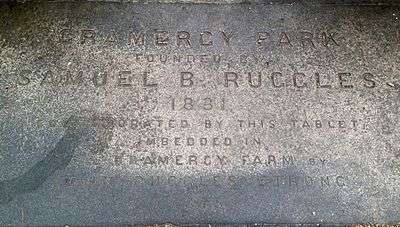
Origin and development
The area which is now Gramercy Park was once in the middle of a swamp. In 1831 Samuel B. Ruggles, a developer and advocate of open space, proposed the idea for the park due to the northward growth of Manhattan. He bought the property,[3] which was then a farm called "Gramercy Farm", from James Duane, son of the former mayor, father of James Chatham Duane, and a descendant of Peter Stuyvesant. To develop the property, Ruggles spent $180,000 to landscape it, draining the swamp and causing about a million horsecart loads of earth to be moved.[19][21] He then laid out "Gramercy Square", deeding possession of the square to the owners of the 66 parcels of land he had plotted to surround it, and sought tax-exempt status for the park, which the city's Board of Aldermen granted in 1832. It was the second private square created in the city, after Hudson Square, also known as St. John's Park, which was laid out by the parish of Trinity Church.[7] Numbering of the lots began at #1 on the northwest corner, on Gramercy Park West, and continued counter-clockwise: south down Gramercy Park West, then west to east along Gramercy Park South (East 20th Street), north up Gramercy Park East, and finally east to west along Gramercy Park North (East 21st Street).[7]
As part of his overall plan for the square, Ruggles also brought about the creation by the state legislature of Lexington Avenue and Irving Place,[note 3] two new north-south roads laid out between Third and Fourth Avenues and feeding into his development at the top and bottom of the park.[21] The new streets reduced the number of lots around the park from 66 to 60.[27]

Gramercy Park was enclosed by a fence in 1833, but construction on the surrounding lots did not begin until the 1840s,[21][28] due to the Panic of 1837.[29] In one regard this was fortunate, since the opening of the Croton Aqueduct in 1842 allowed new townhouses to be constructed with indoor plumbing.[27]
The first formal meeting of the park's trustees took place in 1844 at 17 Union Square (West), the mansion of James W. Gerard, which is no longer extant, having been demolished in 1938.[30] By that time, landscaping had already begun with the hiring of James Virtue in 1838, who planted privet inside the fence as a border; by 1839 pathways had been laid out and trees and shrubs planted.[31] Major planting also took place in 1844[7] – the same year the park's gates were first locked[30] – followed by additional landscaping by Brinley & Holbrook in 1916. These plantings had the effect of softening the parks' prim formal design.[31]
Later 19th century events
In 1863, in an unprecedented gesture, Gramercy Park was opened to Union soldiers involved in putting down the violent Draft Riots which broke out in New York, after conscription was introduced for the Civil War.[19] Gramercy Park itself had been protected with howitzers by troops from the Eighth Regiment Artillery, while the 152nd New York Volunteers encamped in nearby Stuyvesant Square.[21]
At #34 and #36 Gramercy Park (East) are two of New York's first apartment buildings, designed in 1883 and 1905.[32] In addition, #34 is the oldest existing co-operative apartment building in the city.[33] Elsewhere in the neighborhood, nineteenth century brownstones and carriage houses abound, though the 1920s brought the onset of tenant apartments and skyscrapers to the area.

In 1890 an attempt was made to run a cable car through the park to connect Irving Place to Lexington Avenue.[7] The bill passed the New York State Legislature, but was vetoed by Governor David B. Hill.[22] Twenty-two years later, in 1912, another proposal would have connected Irving Place and Lexington Avenue, bisecting the park, but was defeated through the efforts of the Gramercy Park Association, now called Gramercy Neighborhood Associates.[22][34]
In the late 19th century, numerous charitable institutions influential in setting social policy were located on 23rd Street, and some, such as the Federation of Protestant Welfare Agencies, still remain in the area. Calvary Church on Gramercy Park North has a food pantry that opens its doors once a week for one hour, and the Brotherhood Synagogue on Gramercy Park South served as an Underground Railroad station before the Civil War, when the building was a Quaker meeting house, established in 1859.[32]
20th and 21st centuries
The Hotel Irving, at 26 Gramercy Park South, was constructed c.1903.[35] Among its guests was a young Preston Sturges, who stayed there in 1914 while his mother lived with Isadora Duncan at the Ritz-Carlton Hotel. A townhouse on the north side of the Park was provided for Duncan's dancing school, and their studio was nearby on the northeast corner of Park Avenue South (then Fourth Avenue) and 23rd Street.[36] The Hotel Irving was converted to a co-op in 1986.[37]
In the center of the park is a statue of one of the area's most famous residents, Edwin Booth, which was dedicated on November 13, 1918.[38][39][40] Booth was one of the great Shakespearean actors of 19th Century America, as well as the brother of John Wilkes Booth, the assassin of Abraham Lincoln. The mansion at #16 Gramercy Park (South) was purchased by Booth and renovated by Stanford White at his request to be the home of the Players' Club, which Booth founded. He turned over the deed to the building on New Year's Eve 1888.[32][39] Next door at #15 Gramercy Park (South) is the National Arts Club, established in 1884 in a Victorian Gothic mansion which was originally home to the New York Governor and 1876 Presidential Candidate, Samuel J. Tilden. Tilden had steel doors and an escape tunnel to East 19th Street to protect himself from the sometimes violent politics of the day.[32]
On September 20, 1966, a part of the Gramercy Park neighborhood was designated an historic district,[7] the boundaries of which were extended on July 12, 1988.[16] The district was listed on the National Register of Historic Places in 1980.[2] A proposed extension of the district would include nearby buildings such as the Manhattan Trade School for Girls, now the School of the Future, and the Children's Court and Family Court buildings, now part of Baruch College, all on East 22nd Street.[17]
In 1983, Fantasy Fountain, a 4.5 stone (63 lb; 29 kg) bronze sculpture by Greg Wyatt was installed in the park.
One of the most significant steam explosions in New York City occurred near Gramercy Park in 1989, killing two Consolidated Edison workers and one bystander, and causing damage of several million dollars to area buildings.[41]
In 2012, 18 Gramercy Park South – formerly the Salvation Army's Parkside Evangeline Residence for Women and then a facility of the School of Visual Arts – was sold to Eyal Ofer’s Global Holdings and the Zeckendorf brothers for $60 million for conversion into condominium apartments by Robert A. M. Stern, including a $42 million penthouse duplex.[42] The 17-story building is the tallest around the park and dates from 1927.[30]
Ownership and access to the park
As a private park, Gramercy Park is held in common by the owners of the 39 surrounding structures, as it has been since December 31, 1831.[43] Two keys are allocated to each of the original lots surrounding the park, and the owners may buy keys for a fee, which was originally $10 per key, but as of 2008 was $350, with a $1,000 fee for lost keys,[6][43][44] which rises to $2,000 for a second instance.[30] The Medeco locks are changed annually,[31] and any property that does not pay the annual assessment of $7,500 per lot has its key privileges revoked;[30] additionally, the keys are very hard to duplicate.[43] As of 2012, there were 383 keys in circulation, each individually numbered and coded.[30]
Members of the Players Club and the National Arts Club as well as guests of the Gramercy Park Hotel,[45] which has 12 keys,[31] have access, as does Calvary Church and the Brotherhood Synagogue; hotel guests are escorted to the park and picked up later by hotel staff.[30] In addition, the owners of the luxury condominium apartments at 57 Irving Place, which was completed in 2012, will have key access to the park, despite being located several blocks from the park, by becoming members of the Players Club.[46]
At one time, the park was open to the public on Gramercy Day – which changed yearly, but was often the first Saturday in May. In 2007, the trustees announced that the park would no longer be open for Gramercy Day because it "had turned into a street fair".[47] The park, however, continues to be open to the public on Christmas Eve.[48] Visitors to the park at any time cannot drink alcohol, smoke, ride a bicycle, walk a dog, play ball or Frisbee, or feed the birds and squirrels.[30]
In 2001, Aldon James of the National Arts Club that adjoins the park brought about 40 children, mostly minorities, into the park from the nearby Washington Irving High School on Irving Place. The trustee at the time, Sharen Benenson, called police alleging that the children were trespassing.[47] The police refused to take action. Later, a suit was filed against the park's administration in Federal Court.[49][50][51] The suit was settled out of court in 2003. Most of the children settled for $36,000 each, while one received $50,000.[6][52]
In December 2014, it was revealed in the New York Times that 360-degree panoramic pictures of the interior of the park – taken using Photo Sphere, a Google app within Google Street View, by Shawn Christopher from the Pittsburgh area – had been posted to Google Maps. Christopher got access to the park by renting a room through the Airbnb service and using the key to the park which came with the room. The Gramercy Park Block Association – which did not know about the photographs until informed by a Times reporter – did not give Christopher permission to shoot in the park, and he was unaware that photography was generally forbidden.[53][54]
Demographics
Based on data from the 2010 United States Census, the population of Gramercy was 27,988, an increase of 1,804 (6.9%) from the 26,184 counted in 2000. Covering an area of 171.71 acres (69.49 ha), the neighborhood had a population density of 163.0 inhabitants per acre (104,300/sq mi; 40,300/km2).[1]

The racial makeup of the neighborhood was 73.7% (20,623) White, 3.3% (923) African American, 0.1% (19) Native American, 13.4% (3,740) Asian, 0.0% (10) Pacific Islander, 0.3% (77) from other races, and 2.0% (573) from two or more races. Hispanic or Latino of any race were 7.2% (2,023) of the population.[55]
Surrounding neighborhood
The neighborhood, which is called either "Gramercy Park" or "Gramercy", is generally considered to be a quiet and safe area.[12] While real estate in Manhattan is rarely stable, the apartments in the neighborhood around Gramercy Park have experienced little turmoil. East 19th Street between Third Avenue and Irving has been called "Block Beautiful" for its wide array of architecture and pristine aesthetic. Townhouses with generous backyards and smaller apartments alike coincide in a collage of architecture in Gramercy Park. The largest private house in the neighborhood, a 42-room mansion on Gramercy Park South, was on sale for $7 million in 1993.[12]
The Gramercy Park neighborhood is located in the part of Manhattan where the bedrock Manhattan schist is located deeper underground than it is above 29th Street and below Canal Street, and as a result, and under the influence of zoning laws, the tallest buildings in the area top out at around 20 stories, and older buildings of 3-6 floors are numerous, especially on the side streets, but even on the avenues.
The quiet streets perpendicular to Irving Place have maintained their status as fashionable residential blocks reminiscent of London's West End. In 1912, a multiple dwelling planned specifically for bachelors appeared at 52 Irving Place. A Colonial Revival style structure with suites of rooms that lacked kitchen facilities was one of a small group of New York apartment houses planned for single men in the early years of the 20th century.
Gramercy Park Hotel
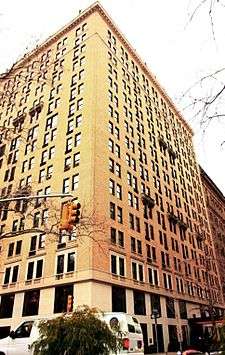
Gramercy Park Hotel was originally designed by Robert T. Lyons and built by Bing & Bing in 1925, replacing a row of townhouses. It was managed for many years by hotelier Herbert Weissberg, and in 2006 underwent a massive makeover by Ian Schrager, who in 2010 sold his interests and is no longer associated with the hotel. Interiors were designed by artist and filmmaker Julian Schnabel. The Hotel has views of Gramercy Park, and guests have access to the hotel's 12 keys to the park during their stay. Dining venues include the Rose Bar and Jade Bar, and rooftop Gramercy Terrace restaurant; Danny Meyer's Maialino is also in the Hotel.
The Hotel was the subject of a 2008 documentary film, Hotel Gramercy Park.[56]
Irving Place
An assortment of restaurants, bars, and establishments line Irving Place, the main thoroughfare of the neighborhood south of the park. Pete's Tavern, New York's oldest surviving saloon and where O. Henry wrote The Gift of the Magi, survived Prohibition disguised as a flower shop. Irving Plaza, at East 15th Street and Irving, hosts numerous concerts for both well-known and indie bands and draws a crowd almost every night. There are also a number of clinics and official city buildings on Irving Place.
Education
Two public high schools are located in the area: Washington Irving High School on Irving Place, and the School of the Future on 22nd Street at Lexington Avenue, which is also a middle school.
P.S. 40, the Augustus Saint-Gaudens School,[57] is the only general public elementary school in the neighborhood, located on East 20th Street between First and Second Avenues, near the Augustus Saint-Gaudens Playground, Peter's Field, and the park at Stuyvesant Square. The building also houses a middle school, the Salk School of Science, named after Jonas Salk. Down the street is M.S. 104 the Simon Baruch Middle School.[58] Nearby, on East 23rd Street, is the American Sign Language and English School, a public elementary and middle school which provides American Sign Language immersion education for deaf and hearing children,[59] the building for which also hosts other public school programs.
Also located in the neighborhood is The Epiphany School, a Catholic elementary school on 22nd Street at Second Avenue. Founded in 1885 for religious instruction in the parish of the Epiphany, the school has been a landmark – gutted and rebuilt – in the neighborhood for generations.[60] At 20th Street and Second Avenue is a new building for the Learning Spring School, a private school for high-functioning autistic children[61] funded by the Simons Foundation Autism Research Initiative.[62] The building houses an elementary and middle school, grades K-8.[63]
The École Internationale de New York, a French international school, is primarily located in the Gramercy Park neighhborhood,[64] partly at 111 East 22nd Street between Park and Lexington Avenues, where the 1st, 2nd and 3rd grades and the Middle School are sited; and partly in the "Renwick Gem" of Calvary Church at 277 Park Avenue, where the 4th and 5th grades are located. There is also a preschool at 206 Fifth Avenue between West 25th and 26th Streets in the NoMad neighborhood.[65]
The buildings of Baruch College of the City University of New York (CUNY) are located in the neighborhood or nearby, as are the facilities of The School of Visual Arts, on East 23rd Street and elsewhere. The Gramercy Park Women's Residence, George Washington Hotel and the New Residence house students from the school.
The neighborhood is served by the Epiphany branch of the New York Public Library on East 23rd Street.
Hospitals
Although the neighborhood is not far from "hospital row" on First Avenue above 23rd Street, the primary medical center in its boundaries is Beth Israel Medical Center between East 15th and 17th Streets off of First Avenue. Nearby is the Hospital for Joint Diseases, part of the NYU Medical Center, and the New York Eye and Ear Infirmary on 14th Street. Cabrini Medical Center, on East 19th and 20th Streets, closed down in 2008, but the buildings were purchased by Memorial Sloan-Kettering Cancer Center in 2010, for use as a cancer outpatient facility.[66]
Notable residents
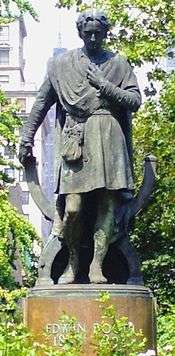
Around the park
- #1 – Amos Pinchot – former Governor of Pennsylvania[67]
- #1 – Valentine Mott – an original resident, chief medical officer of the Union Army and founder of Bellevue Hospital and NYU Medical School[22]
- #3&4 – James Harper – an original resident, 1847–1869,[19] Mayor of New York from 1844–1845 and one of the founders of the Harper publishing firm;[22][67] the two iron lamps outside #4 were placed there by the city in Harper's honor: the custom was that mayor's residences were so distinguished so that he would be available for nighttime emergencies[22]
- #5 – Vincent Astor – businessman, philanthropist, member of the Astor family[67]
- #7 – Julia Roberts[30]
- #10 – Henrietta B. Haines – novelist[67]
- #11 – Robert Henri – American painter[30]
- #11 – Samuel L. M. Barlow II – composer, patron of the arts[67]
- #15 – Samuel J. Tilden – whose house, a National Historic Landmark, is now the National Arts Club[7]
- #16 – Edwin Booth – famed Shakespearean actor, founded the Players Club
- #19 – Stuyvesant Fish – a leader of New York society (1887)[7]
- #19 – Edward Sheldon – playwright[22]
- #19 – William C. Bullitt – diplomat, journalist and novelist[22]
- #24 – Richard Watson Gilder – the poet and editor died in this house[22]
- #24 – Thomas Alva Edison – inventor[30]
- #24 – Albert Gallatin – Secretary of the Treasury[67]
- #26 – Booth Tarkington – novelist and dramatist[30]
- #26 – Steinway family – manufacturers of Steinway pianos[67]
- #34 – James Cagney, Margaret Hamilton, and Gregory Peck,[30]
- #36 – John Barrymore – star of stage and screen[68]
- #36 – Daniel Chester French – sculptor responsible for the seated figure of Lincoln at the Lincoln Memorial in Washington, D.C.[68]
- #36 – Alfred Ringling – founder of the Ringling Brothers Circus[68]
- #38 – John Steinbeck – American author[30]
- #44 – Hart Crane – poet[30]
- Where the Gramercy Park Hotel and the connected 50 Gramercy Park North co-op are now located:
- Stanford White – architect[69]
- Robert G. Ingersoll – orator
- Elsewhere around the park:
- John Bigelow – lawyer and statesman, who lived at 21 Gramercy Park[22][70]
- Henry Herbert – English actor and producer
- Robert H. Ingersoll – businessman[22]
- Karl Lagerfeld – fashion designer[30]
- Maud Powell – female concert violinist and suffrage pioneer who cast her first ballot in 1919[71]
- George Templeton Strong – lawyer and diarist, an original resident, who lived at 55 Gramercy Park North[72]
- Uma Thurman – actress[30]
- Rufus Wainwright – musician[30]
Around the neighborhood
- Peter Cooper – industrialist, entrepreneur and philanthropist, lived just north of the park at 9 Lexington Avenue.[22]
- Joseph P. Day (1874-1944), real estate broker and developer and auctioneer
- Theodore Roosevelt's birthplace on 20th Street is a National Historic Site.
- Edith Wharton – author, born at 14 West 23rd Street and attended Calvary Church[73]
- Oscar Wilde lived on East 17th and Irving Place for a while, next to his interior designer Elsie de Wolfe and her partner, literary agent Elisabeth Marbury, said to be the most fashionable lesbian couple of Victorian New York.
- Chelsea Clinton, the daughter of U.S. President Bill Clinton and First Lady Hillary Clinton, as well as her husband Marc Mezvinsky, used to live in the neighborhood before moving to nearby NoMad, selling their apartment for $4 million.[74][75]
Many actors, actresses and artists live in the district including Kate Hudson, Whitney Port, Joshua Bell, Jimmy Fallon and Amanda Lepore.[30] Amanda Peet grew up in the neighborhood. Winona Ryder once resided in Gramercy Park, but sold her co-operative apartment in 2008.[76] The fashion designer Narciso Rodriguez has his studio on Irving Place and the neighborhood is home to numerous models' apartments from nearby agencies on Broadway. NBC News anchor Ann Curry also lives in the neighborhood.
In popular culture

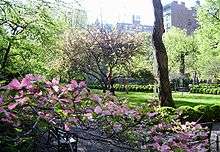
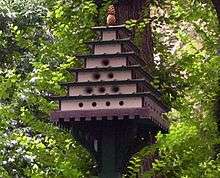
Literature:
- 1892: John Seymour Wood's Gramercy Park: A Story of New York may be one of the first literary works set in the area
- 1945: In E. B. White's children's book Stuart Little, the Little family live at "22 Gramercy Park",[77] which White describes as "[A] pleasant place near a park in New York City." White also wrote a poem called "Gramercy Park", which was published in The New Yorker, about him and a friend climbing over the fence into the park.[78]
- 1949: Henry Noble MacCracken's The Family on Gramercy Park is set in the neighborhood.
- 1961: Medusa in Gramercy Park is a book of poems by Horace Gregory
- 1963: It's Like This, Cat, the Newbery award winning children's book set in Gramercy Park is published.
- 1965: The address in the title of Priscilla Dalton's 90 Gramercy Park does not actually exist.
- 1970: A character in Jack Finney's Time and Again lives in 19 Gramercy Park South around 1882.
- 1982: In The Brownstone House of Nero Wolfe by Ken Darby, the character Archie Goodwin states that Nero Wolfe's townhouse was actually on East 22nd Street in the Gramercy Park district rather than the fictional West 35th street address(es) given in the novels to protect Wolfe's privacy.[79]
- 1983: Bruce Nicolaysen's The Pirate of Gramercy Park is part of the Novel of New York multi-generation family historical fiction series.
- 1988: In the book Changes for Samantha, part of the American Girl series, Samantha stays at her Uncle Gardner and Aunt Cordelia's brownstone house in Gramercy Park.
- 2001: The mystery novel Murder on Gramercy Park by Victoria Thompson is part of the Gaslight Mystery series
- 2003: Paula Cohen's historical novel Gramercy Park is set in 1894.
- 2005: The Monsters of Gramercy Park by Danny Leigh is a psychological thriller.
- 2006: Several key scenes of Jed Rubenfeld's historical thriller The Interpretation of Murder, which is set in New York in 1909, take place in the park itself and the houses nearby, where one of the book's main protagonists lives.
- 2007: The Luxe, a book by Anna Godbersen, takes place in the neighborhood around Gramercy Park.
- 2010: In his memoir Assholes Finish First, Tucker Max recounts that he gained access to Gramercy Park to win a bet with a female acquaintance. To satisfy her end of the bet, she was required to give him fellatio while he was sitting on a bench in the park.
Films: (Note: Gramercy Park is a private park, and film companies are not usually allowed to shoot there.)
- 1973: In the science fiction film Soylent Green, which is set in New York in 2022, a corrupt New York governor escorts some children into a tent, saying, "This was once called Gramercy Park, boys. Now it's the only tree sanctuary in New York."
- 1979: In the film The Warriors, one of the fictional gangs featured is the Gramercy Riffs, the biggest gang in New York.[80]
- 1993: The exterior of the park can be seen in the Woody Allen film Manhattan Murder Mystery. The characters in the film comment on the beauty of the park from a wine tasting filmed in the National Arts Club. Later in the film Diane Keaton and Alan Alda walk into the street directly in front of the park as they try to track a bus route.
- 1999: In the film Notting Hill, a famous actress, played by Julia Roberts, is shown starring in a film called Gramercy Park, which was also the name of the production company for Notting Hill.
- 2014: In the film That Awkward Moment, a couple, played by Zac Efron and Imogen Poots, steal a key to the park while being shown a house in Gramercy Park.[81]
Music:
1969 - American guitarist/songwriter Stefan Grossman released an album called The Gramercy Park Sheik
- 1989: American jazz-funk/soul-jazz saxophonist Grover Washington, Jr.'s album Time Out of Mind contains a track titled "Gramercy Park."[82]
- 1997: Australian singer-songwriter Ben Lee released a song titled "Grammercy [sic] Park Hotel" on his album Something to Remember Me By.
- 2000: Jazz fusion/rock duo Steely Dan mentioned of the park in "Janie Runaway", from its album Two Against Nature: Down in Tampa the future looked desperate and dark / Now you're the wonder waif of Gramercy Park.
- 2001: Dutch jazz pianist Michiel Borstlap owns a record label called "Gramercy Park" and he also composed a tune with the same name.
- 2002: Electronic rock band Deadsy released a song entitled "The Key to Gramercy Park" on their album Commencement.
- 2013 American guitarist Steve Hunter's album The Manhattan Blues Project contains a track titled "Gramercy Park".
Gallery
- Around the Park
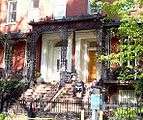 #3&4: Doorways of the Greek Revival townhouses, design attributed to Alexander Jackson Davis ,[7] "one of America's most versatile 19th century architects"[83]
#3&4: Doorways of the Greek Revival townhouses, design attributed to Alexander Jackson Davis ,[7] "one of America's most versatile 19th century architects"[83]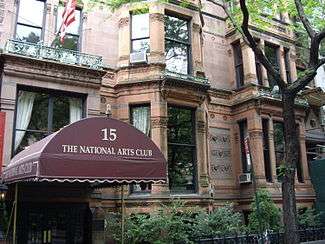 #15: The National Arts Club, former home of Samuel J. Tilden, remodeled for Tilden by Calvert Vaux [83]
#15: The National Arts Club, former home of Samuel J. Tilden, remodeled for Tilden by Calvert Vaux [83] 19 Gramercy Park South, built in 1845 and remodeled in 1887 for Stuyvesant Fish.[7] John Barrymore lived here while working on Broadway.[83]
19 Gramercy Park South, built in 1845 and remodeled in 1887 for Stuyvesant Fish.[7] John Barrymore lived here while working on Broadway.[83]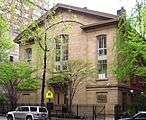 #28: The Brotherhood Synagogue was a stop on the Underground Railroad when it was a Quaker meeting house [32] The Travelers' Aid Society grew out of one of the congregation's activities.[22]
#28: The Brotherhood Synagogue was a stop on the Underground Railroad when it was a Quaker meeting house [32] The Travelers' Aid Society grew out of one of the congregation's activities.[22]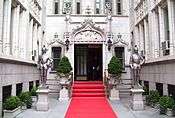
- Around the neighborhood
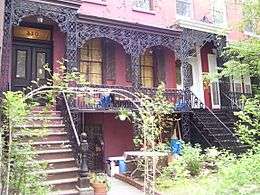 Italianate townhouses[84] on East 18th Street (1853), with cast-iron verandas reminiscent of the French Quarter of New Orleans.[83]
Italianate townhouses[84] on East 18th Street (1853), with cast-iron verandas reminiscent of the French Quarter of New Orleans.[83]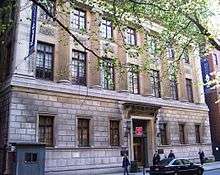 The former Children's Court, now part of Baruch College of CUNY
The former Children's Court, now part of Baruch College of CUNY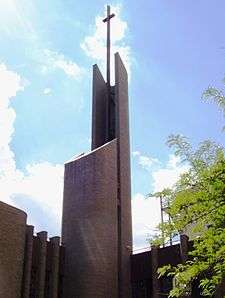 Steeple of Epiphany Roman Catholic Church "The most positive modernist religious statement on Manhattan Island to date."[83]
Steeple of Epiphany Roman Catholic Church "The most positive modernist religious statement on Manhattan Island to date."[83]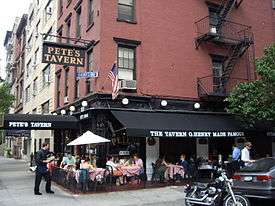 Pete's Tavern, where urban legend has it that O. Henry wrote "The Gift of the Magi", was formerly the Portman Hotel.[83]
Pete's Tavern, where urban legend has it that O. Henry wrote "The Gift of the Magi", was formerly the Portman Hotel.[83] A converted carriage house on East 19th Street between Irving Place and Third Avenue, a block often referred to as "Block Beautiful"[83]
A converted carriage house on East 19th Street between Irving Place and Third Avenue, a block often referred to as "Block Beautiful"[83]
See also
-
 New York City portal
New York City portal
References
Explanatory notes
- ↑ Sometimes misspelled as Grammercy
- ↑ Neighborhoods in New York City do not have official status, and their boundaries are not specifically set by the city. (There are a number of Community Boards, whose boundaries are officially set, but these are fairly large and generally contain a number of neighborhoods, and the neighborhood map issued by the Department of City Planning only shows the largest ones.)
- ↑ Ruggles named Irving Place after Washington Irving, but Irving never lived there, although he frequently visited a nephew who lived nearby.
Citations
- 1 2 Table PL-P5 NTA: Total Population and Persons Per Acre - New York City Neighborhood Tabulation Areas*, 2010, Population Division - New York City Department of City Planning, February 2012. Accessed June 16, 2016.
- 1 2 National Park Service (2008-04-15). "National Register Information System". National Register of Historic Places. National Park Service.
- 1 2 Kugel, Seth "Weekend in New York: Gramercy Park; The Ultimate Neighborhood Park" New York Times, July 23, 2006. Accessed July 7, 2006 "A visit to the Gramercy Park neighborhood, on the East Side of Manhattan, can be frustrating...But the easily walkable neighborhood deserves a tour..."
- ↑ "Neighborhood Profile: Gramercy Park" New York March 10, 2003. Accessed July 7, 2009.
- ↑ "Suspect sought in attempted sex assault" WABC-TV Eyewitness News, February 19, 2009. Accessed July 7, 2009 "Eyewitness news reporter Jim Dolan is in Gramercy Park tonight with the very latest...Reporting live from Gramercy Park, Jim Dolan, Eyewitness News."
- 1 2 3 Bonanos, Christopher, ed. "Gotham Real Estate: No Walk in the Park" New York (May 21, 2005). Retrieved July 3rd 2007]
- 1 2 3 4 5 6 7 8 9 10 11 12 "Gramercy Park Historic District" at the NYC Landmarks Preservation Commission "Unlike any other district in New York, Gramercy Park, which was planned as a fashionable residential neighborhood, has always remained a fashionable residential neighborhood."
- ↑ Konigsberg, Eric (June 19, 2008). "The Guardian of Gramercy Park". New York Times. Retrieved 2014-12-07.
Gramercy is one of two private parks in New York City (the other, in Queens, is Sunnyside Gardens Park) and a key is required not only to enter, but to leave through a gate in its wraparound wrought-iron fence.
- ↑ "Sunnyside" on Forgotten NY
- ↑ Vitullo-Martin, Julia. "A Pioneering Queens Garden Community Flourishes Anew" New York Sun (July 7, 2005)
- ↑ Lisi, Michael (2001-12-05). "Washington Park, Troy". Times Union. Hearst Corporation.
- 1 2 3 4 5 Cohen, Joyce. "If You're Thinking of Living In/Gramercy Park; A Long Sense of History, And a Private Park", The New York Times, August 29, 1999. Accessed July 30, 2007. "Most distinctive of all is that Gramercy Park itself is the only private park in the city. Landscaped and leafy, the park defines the neighborhood, which runs from 14th to 23d streets and Park Avenue South to Third Avenue. The gates are locked for all but one afternoon a year, usually the first Saturday in May, when the park is open to the public."
- ↑ Community Board 5
- ↑ Community Board 6
- ↑ Devree, Charlotte. "Private Life of a Park" New York Times (December 8, 1957), quoted in "Gramercy Park Historic District" at the NYC Landmarks Preservation Commission
- 1 2 "Gramercy Park Historic District and Extension" map at nyc.gov
- 1 2 "Proposed Gramercy Park Historic District Extension" on the Gramercy Neighborhood Associates website
- 1 2 Moscow, Henry (1978), The Street Book: An Encyclopedia of Manhattan's Street Names and Their Origins, New York: Hagstrom, ISBN 0823212750, s.v. "Gramercy Park": "Crommessie, the Dutch for 'crooked little knife', which described the shape of a brook and hill on the site. Judith Stuyvesant, widow of Governor Peter Stuyvesant referred to "Cromessie" in a deed she signed in 1674."
- 1 2 3 4 Davis-Krum, Harriet. "Gramercy Park" in Jackson, Kenneth T., ed. (1995), The Encyclopedia of New York City, New Haven: Yale University Press, ISBN 0300055366 p.497
- 1 2 Ramos, Sandra. Gramercy Park profile, New York. Accessed September 30, 2007.
- 1 2 3 4 5 6 Burrows, Edwin G. & Wallace, Mike (1999), Gotham: A History of New York City to 1898, New York: Oxford University Press, ISBN 0-195-11634-8; page 577
- 1 2 3 4 5 6 7 8 9 10 11 12 13 Federal Writers' Project (1939), New York City Guide, New York: Random House, ISBN 0-403-02921-X (Reprinted by Scholarly Press, 1976; often referred to as WPA Guide to New York City), pp.191-198
- ↑ Valentine's Manual of Old New York. No. 4, New Series. Edited By Henry Collins Brown. Valentine's Manual, Incorporated, 1920, New York.
- ↑ New York: Old & New; Its Story, Streets, and Landmarks, Volume 2. Rufus Rockwell Wilson. Lippincott, 1902 - New York.
- ↑ "Gramercy" and Crummassie-Vly. ROBERT McLEOD JACKSON. Letters Page, New York Times, March 01, 1909
- ↑ http://www.merriam-webster.com/dictionary/gramercy
- 1 2 Nevius, Michelle & Nevius, James (2009), Inside the Apple: A Streetwise History of New York City, New York: Free Press, ISBN 141658997X, p.69
- ↑ "Gramercy Park", New York Times, (July 3, 1921), editorial on the 90th anniversary of the dedication of Gramercy Park.
- ↑ Burrows, Edwin G. & Wallace, Mike (1999), Gotham: A History of New York City to 1898, New York: Oxford University Press, ISBN 0-195-11634-8; page 612
- 1 2 3 4 5 6 7 8 9 10 11 12 13 14 15 16 17 18 19 Finn, Robin. "Two-Acre Zone: The neighborhood isn’t gated, but Gramercy Park is". New York Times (September 30, 2012)
- 1 2 3 4 Mendelsohn, Joyce (1998), Touring the Flatiron: Walks in Four Historic Neighborhoods, New York: New York Landmarks Conservancy, ISBN 0-964-7061-2-1, OCLC 40227695
- 1 2 3 4 5 Wurman, Richard Saul (2000), Access New York City, New York: HarperCollins, ISBN 0-06-277274-0
- ↑ Nevius, Michelle & Nevius, James (2009), Inside the Apple: A Streetwise History of New York City, New York: Free Press, ISBN 141658997X, p.151
- ↑ Garmey, Stephen Gramercy Park :An Illustrated History of a New York Neighborhood. 1984. ISBN 0-917439-00-7
- ↑ New York City Geographic Information System map
- ↑ Sturges, Preston; Sturges, Sandy (adapt. & ed.), Preston Sturges on Preston Sturges, Boston: Faber & Faber, ISBN 0571164250, p.120
- ↑ "26 Gramercy Park South" on the Evans & Nye website
- ↑ "Booth Statue Unveiled" New York Times" (November 14, 1918)
- 1 2 "Booth Statue in Gramercy Park" New York Times (November 17, 1918)
- ↑ "New York Honors Edwin Booth" Theatre Magazine (v.29 n.1, 1919)
- ↑ Pitt, David E. "2 Dead and 19 Hurt in Blast Of a Submerged Steam Pipe", New York Times (August 20, 1989). Accessed September 30, 2007. "A 24-inch underground steam pipe exploded with a thunderous roar in the Gramercy Park section of Manhattan yesterday evening, killing two people and injuring 19 others, the police said."
- ↑ http://www.18gramercypark.com/
- 1 2 3 Konigsberg (2008)
- ↑ Ahern, Kaitlin "Living in Gramercy Park" on NYLuxury.com (December 1, 2009) Accessed: 7 Jan 2011
- ↑ Gramercy Park Hotel Features List Retrieved on July 3rd, 2007
- ↑ Arak, Joey. "57 Irving Place Sneaks Into Gramercy Park Through Back Door". Curbed New York (August 4, 2008)
- 1 2 Molloy, Joanna. "Gramercy Park Siege: Manhattan's only private oasis is site of battle to make it open to the public" New York Daily News (20 April 2010)
- ↑ "Gramercy Park no longer open first Saturday in May" on NewYorkOlogy (May 2, 2007).
- ↑ Kleinfeld, N. R. "Federal Lawsuit Charges Racial Exclusion at Gated Gramercy Park", New York Times (January 18, 2001)
- ↑ Smith, Greg. "Kids Chased From Gramercy Park, Bias Suit Says" New York Daily News (January 18, 2001)
- ↑ Rish, George and Molloy, Joanna with Anderson, Kasia and Rubin, Lauren. "Madonna 'Grabs' London Spotlight" New York Daily News (May 15, 2002)
- ↑ Fried, Joseph. "Following Up" New York Times (September 28, 2003)
- ↑ Chaban, Matt A. V. "Peek in Gramercy Park, Key No Longer Required" New York Times (December 1, 2014)
- ↑ Chaban, Matt A. V. "Times Insider: Story Behind the Story: Sneaking a Peek at a Protected Gramercy Park View" New York Times (December 4, 2014)
- ↑ Table PL-P3A NTA: Total Population by Mutually Exclusive Race and Hispanic Origin - New York City Neighborhood Tabulation Areas*, 2010, Population Division - New York City Department of City Planning, March 29, 2011. Accessed June 14, 2016.
- ↑ Hotel Gramercy Park (documentary) – official website.
- ↑ "P.S. 040 Augustus Saint-Gaudens" official website
- ↑ "Baruch Middle School" official website
- ↑ "'47' American Sign Language and English Lower School" official website
- ↑ Epiphany School official website
- ↑ LearningSpring School website
- ↑ SFARI website
- ↑ "Full Board Meeting Minutes" of Manhattan Community Board 6 (February 11, 2009)
- ↑ Burton, Monica. "A Language en Vogue." Shoe Leather. Arthur L. Carter Journalism Institute, New York University, 2011. p. 1 (Archive). Retrieved on May 1, 2015.
- ↑ École International de New York website
- ↑ "Cabrini purchase gets green light; Helmsley Middletown hotel to close" Crain's New York Business (February 7, 2010)
- 1 2 3 4 5 6 7 Jackson, Kenneth T. (1985), Crabgrass Frontier: The Suburbanization of the United States, New York: Oxford University Press, ISBN 0-19-504983-7, pp.22-23
- 1 2 3 4 See the plaque on the building at File:36 Gramercy Park plaque.jpg
- ↑ "A Rich History of the Gramercy Park Hotel"
- ↑ Staff. "JOHN BIGELOW DIES IN HIS 95TH YEAR; Venerable Author, Diplomat, and Lawyer Passes Away at His Gramercy Park Home.", The New York Times, December 20, 1911. Accessed August 3, 2016. "John Bigelow, venerable man of letters, diplomatist, and lawyer, died yesterday morning at his home, 21 Gramercy Park, at the age of ninety-four."
- ↑ "Time Line Maud Powell's Life and Career"
- ↑ George Templeton Strong Residence, New York City Chapter of the American Guild of Organists. Accessed August 3, 2016.
- ↑ Diamond, Jason. "Edith Wharton by Design" Paris Review (January 24, 2013)
- ↑ Seelye, Katherine Q.; Haughney, Christine (July 31, 2010). "Town Elbows Its Way Into Clinton Wedding". The New York Times. Retrieved December 18, 2013.
- ↑ Heller, Jill (March 15, 2013). "Chelsea Clinton Apartment: Former First Daughter Scoops Up $10.5 Million Madison Square Park Pad". International Business Times. Retrieved March 16, 2013.
- ↑ "Winona Ryder Sells Lexington Avenue Apartment for $2.2 Million". New York Post', June 24, 2008. Accessed July 19, 2013.
- ↑ "Meet Mister Little" Daytona Beach Morning Journal (March 6, 1966)
- ↑ Elledge, Scott. E. B. White: A Biography. New York: W. W. Norton, 1986. ISBN 0-393-30305-5
- ↑ Darby, Ken, The Brownstone House of Nero Wolfe, p. 8
- ↑ Bitette, Nicole. "GANGS OF NEW YORK: The NYC crews that ran the streets in The Warriors", New York Daily News, February 9, 2016. Accessed July 18, 2016. "The Gramercy Riffs - Gramercy, Manhattan"
- ↑ Foundas, Scott. "Film Review: That Awkward Moment", Variety (magazine), January 28, 2014. Accessed July 18, 2016. "Gormican begins and ends That Awkward Moment with Efron’s Jason sitting alone and forlorn on a bench in Gramercy Park on a chilly winter’s night, and in between flashes back to show us how he got there."
- ↑ Allmusic: Time Out of Mind - Grover Washington, Jr.
- 1 2 3 4 5 6 7 8 White, Norval & Willensky, Elliot (2000), AIA Guide to New York City (4th ed.), New York: Three Rivers Press, ISBN 978-0-8129-3107-5
- ↑ 1975 historic plaque on site, placed by New York Community Trust
Further reading
- "Gramercy Park", New York Times (July 3, 1921) Editorial on Gramercy Park's 90th anniversary and some history.
- "Samuel B. Ruggles, Founder Of Gramercy Park", Antiques Digest, reprinted. Originally published 1921.
- Brooks, Gladys. Gramercy Park: Memories of a New York Girlhood New York: Dutton, 1958.
- Klein, Carole. Gramercy Park: An American Bloomsbury New York: Houghton Mifflin, 1987.
- Mendelsohn, Joyce (1998), Touring the Flatiron: Walks in Four Historic Neighborhoods, New York: New York Landmarks Conservancy, ISBN 0-964-7061-2-1, OCLC 40227695
- Pine, John B. The Story of Gramercy Park (1921)
External links
| Wikimedia Commons has media related to |
- Gramercy Park in the NYC Insider: an Insider's Guide to New York City
- "Gramercy Park Historic District and Extension" map at nyc.gov
- "Proposed Gramercy Park Historic District Extension" on the Gramercy Neighborhood Associates website
- Gramercy Park on Citysearch NYC
- History of the Gramercy Park Hotel
Images
- New York Architecture Images- SEARCH- gramercy park, kips bay
- recent photos of Gramercy Park
- photo tour of the Gramercy Park area
| Flatiron District, Madison Square, NoMad | Rose Hill, Kips Bay | Kips Bay | |
| Flatiron District | |
Stuyvesant Town–Peter Cooper Village | |
| |||
| | |||
| NoHo | Union Square | East Village |
